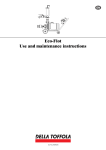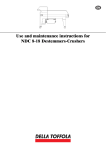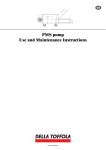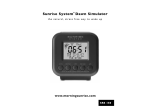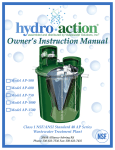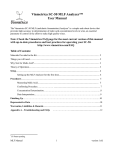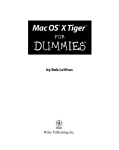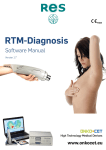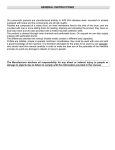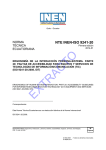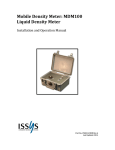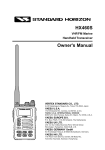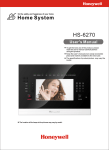Download Use and maintenance instructions Grape vibrating sorting table SV
Transcript
EN Use and maintenance instructions Grape vibrating sorting table SV 0308R00 EN Read all the following safety recommendations very carefully before undertaking any action whatsoever with your machine. FIRST LEARN AND THEN ALWAYS FOLLOW ALL THE SAFETY RECOMMENDATIONS Read these safety recommendations very carefully before installing and using the machine. Also read all the explanatory and warning signs attached to the machine itself. Make sure that they are always easy to read, replacing any damaged or missing signs without delay. Read this manual carefully before using the machine to make sure that you are thoroughly familiar with how it works and all the controls. Never postpone learning this important information until you are already working with the machine. Never allow any unauthorized persons unfamiliar with the equipment to come into the vicinity or operate the machine. Always keep this manual readily available so that anyone taking action on the machine can refer to it. If the machine is sold or transferred to third parties, it is compulsory to hand over all the related technical documentation, use and maintenance EXPLANATION OF THE SYMBOLS Several symbols are used in this manual and on the machine itself to accompany hazard warnings and safety recommendations. These warnings and recommendations serve primarily to ensure the safety of Installers, Technicians and Operators, but also to avoid the machine being damaged. THIS SYMBOL IS USED TO DRAW YOUR ATTENTION TO THE RISK OF FATAL ACCIDENTS, SEVERE INJURIES AND EXTENSIVE DAMAGE IN THE EVENT OF THE SPECIFIED SAFETY MEASURES BEING DISREGARDED. THIS SYMBOL DRAWS ATTENTION TO RISKS OF A GENERAL NATURE. THIS SYMBOL IS USED TO DRAW YOUR ATTENTION TO THE RISK OF FATAL ACCIDENTS, SEVERE INJURIES AND EXTENSIVE DAMAGE IN THE EVENT OF THE SPECIFIED SAFETY MEASURES BEING DISREGARDED. THIS SYMBOL DRAWS ATTENTION TO RISKS DERIVING FROM THE PRESENCE AND USE OF ELECTRICITY. IMPORTANT This word is used to identify paragraphs in the manual containing essential information concerning the machine. Read the related information DEFINITIONS The following are definitions of the individual and legal entities involved in handling and using the machine. OWNWER: In this user manual, the OWNER is the legal representative of the company or body, or the individual, that purchased the machine. The Owner is responsible for ensuring compliance with all the safety requirements specified in the present manual and in the current legislation in the country where the machine is installed. This last aspect is waived if the Owner appoints a plant MANAGER, who thus takes responsibility for implementing the safety recommendations and for compliance with the safety standards relating to the use of the machine and relations with the OPERATOR. INSTALLER: In this user manual, the INSTALLER is the legal representative of the company appointed by the OWNER to install and connect the machine to the hydraulic, electrical and compressed air supply networks (etc.) at the plant. The Installer is responsible for correctly handling and installing the machine in compliance with the recommendations of this manual and with the current legal requirements in the country where the machine is used. OPERATOR: In this user manual, the OPERATOR is the person authorized by the OWNER or MANAGER to take all action on the machine for its usage, adjustment, control and routine servicing, as detailed in this manual (with which Operators must strictly comply, limiting their action to the explicitly allowable procedures). TECHNICIAN: In this user manual, the TECHNICIAN is the person directly authorized by the Manufacturer or, failing this (and entirely under the latter's responsibility), by the Manufacturer's Dealer in the various European Community states outside Italy, to carry out all extraordinary servicing procedures, as well as any adjustments, tests, repairs and replacements of parts proving necessary during the working life of the machine. GENERAL SAFETY RECOMMENDATIONS ! In unloading the machine on arrival, lifting and positioning it at the workplace, and all other handling procedures, comply scrupulously with the recommendations of the relevant section of this manual. Pay particular attention when handling wheel-mounted machines, which have to be moved by hand once they are on the ground. To prevent any risk of crushing, only move the machine by pushing it, never by pulling it, so that nobody can ever come to be in the path of the machine as it moves. Anyone handling the machine must be supervised by another person uninvolved in the procedure, who shall keep a constant watch to ensure that no obstacles or persons get in the machine's way and no other hazardous situations occur. This supervisor must promptly alert the person moving the machine of any hazards so that the machine can be stopped immediately. ! The surface on which the machine slides, like the surface on which it is used, must meet all the essential safety requirements: it must be perfectly horizontal and smooth, with nothing to interfere with the machine's movements. Check in advance to ensure that the whole distance to cover with the machine meets all the above-mentioned requirements. Make sure that the sliding and supporting surfaces have a load-bearing capacity sufficient to withstand the weight of the machine both empty and in use. Any discontinuity in the floor, e.g. expansion joints, grids and manholes, must meet the specified requirements. ! ! ! Never, for any reason whatsoever, lift the machine by any hoisting points other than those indicated. Before the machine is used, it must always be immobilized using the fixing devices provided. The machine must be placed in an area accessible only to the OPERATORS and TECHNICIANS; failing this, it must be protected by a barrier situated at least 2 m away from its outer edge. OPERATORS and TECHNICIANS may access the area where the machine is used providing they are adequately clothed and equipped with the personal protective equipment specified by law (safety shoes, gloves, helmet, etc.). The INSTALLER's personnel, or any visitors, must always be accompanied by an OPERATOR. Unauthorized personnel must never be allowed to remain alone in the vicinity of the machine. The place of installation must be made inaccessible to children. ! OPERATORS shall restrict themselves to taking action on the machine's controls, so they must not open any of the panels, except for the one for accessing the controls (if any). ! The INSTALLER shall restrict himself to taking action on the connections between the plant and the machine, so he must not open any panels, or operate any controls. ! In all handling, usage, servicing or repairs on the machine, it is compulsory to comply with all current safety standards in the country where the machine is used. This applies both to the equipment and to the operating methods adopted. ! Always disconnect the electric power supply before taking any action to install, service, repair or move the machine. This is of fundamental importance to prevent the risk of death, severe injury and extensive damage to the plant. ! In certain stages of normal use, some of the containers comprising the machine are under pressure (e.g. the filter vessel, plenum chamber, erosion-type dosing units, etc.). Never open such containers or remove any components connected to them before you have completely vented said pressure. Venting must be done through the valves provided on the machine specifically for this purpose. ! ! ! ! ! ! ! ! ! ! ! ! ! ! ! Never move the machine during normal working cycles. Before each new working cycle, make sure that any mobile electric connections (power cords, plugs, etc.) are sound and efficient. If they show any signs of damage, repairs must be made only by a specialized TECHNICIAN. Never take any action not mentioned in this manual under your own initiative. Connect the machine to the mains electric power supply according to the recommendations of this manual. Before starting the machine, check the efficiency of the earthing for the electric circuitry and machine frame or structure. Never use power cords of inadequate cross-section or provisional connections, not even briefly, and certainly not in the event of an emergency. Start the machine only after you have made sure of its perfectly safe connection to the systems providing the energy and anything else it needs to function properly (mains electricity and water, compressed gas supply, water drainage network, etc.). Keep a safe distance from any mechanical parts in motion. Immediately report any alarms or the tripping of any automatic machine safety devices to the TECHNICIAN. Never manually reset the machine after an alarm or an automatic safety device has been tripped without first identifying and dealing with the problem that caused them. Never remove the guards over moving parts while the machine is in operation. Before starting the machine, make sure all guards are correctly installed. Routinely perform all the scheduled servicing operations. Dispose of the packaging material for the machine at a suitable landfill, taking particular care over any film and plastic bags, which can expose children to the risk of suffocation. Never release the processing waste deriving from the working process directly into the environment. REGULATIONS FOR USING THE MACHINE IN THE FOODSTUFFS SECTOR The following considerations apply only to machines used with foodstuffs, i.e. destined to come into contact with products for human consumption: The machine in your possession has been designed and built to make it suitable for contact with foodstuffs, and fluids in particular. If in doubt about the intended uses of your machine, refer to the relevant chapter in this manual. ! ! For logistic reasons related to the phases prior to its use (e.g. transport to the user's premises, storage in warehouses, etc.), it is impossible to guarantee the delivery of the machine in conditions suitable to enable its immediate use without an accurate, preliminary sanitization. This is the responsibility of the end user, who may have to comply with any established protocols, e.g. HACCP. DEMOLITION AND DISPOSAL OF THE MACHINE ! At the end of its working life, the machine must be demolished and disposed of. ! THE MACHINE MUST ONLY BE DEMOLISHED AND DISPOSED OF BY ADEQUATELY-TRAINED AND PROPERLY-EQUIPPED PERSONNEL IN COMPLIANCE WITH THE FOLLOWING PROCEDURE. ! 1. Divide the machine into its constituent parts, separating the materials it is made of: ! ! ! ! ! ! ! ! ! mechanical parts (reducers, pump bodies, etc.); metal parts (structure, piping, etc.) electrical parts; rubber parts; plastic and synthetic parts. 2. All resulting materials must be treated and disposed of in accordance with the legal requirements in the country where the machine is used. 3. All components contaminated by oil and oily residues must be considered as special waste and disposed of by authorized consortiums. The same applies to the lubricants that periodically have to be changed. 4. In the event of the machine being placed out of commission, even only temporarily, it must be stored in an area inaccessible to children. All circuit breakers and isolators must be segregated and disconnected. Make a thorough check and release any built-up residual energy, e.g. liquids or gases under pressure inside containers or piping. The machine must also be checked from the static standpoint, to eliminate the risk of any single machine parts moving unexpectedly. THE MANUFACTURER ACCEPTS NO LIABILITY FOR DAMAGE TO PERSONS OR PROPERTY DUE TO THE RE-USE OF SINGLE MACHINE PARTS FOR ANY OTHER THAN THE ORIGINAL PURPOSES OR IN OTHER ASSEMBLY CONDITIONS. INSPECTION OF THE GOODS ON RECEIPT When it is delivered, the machine must be checked by the Customer to identify any signs of damage that it may have suffered in transit and ensure that the machine is complete in every part, as listed on the order form. If there are signs of damage, make an immediate note of the anomalies detected on the transport document (delivery note or CMR), adding the wording “RECEIVED WITH RESERVE DUE TO EVIDENT DAMAGE TO THE MACHINE”. Delivery ex works includes insurance coverage for any damage in accordance with the Italian law 450 of 22.08.1985 "Compensation limit". In the event of complaints, the Customer must be able to produce an adequate photographic documentation of the most obvious damage. GUARANTEE The Manufacturer guarantees the machine for the period indicated in the order form. The GUARANTEE consists exclusively in the replacement or repair, free of charge, of any parts acknowledged as being defective. The GUARANTEE does not cover electrical parts. The GUARANTEE is valid only if all installation and usage instructions have been followed (not only those stated by the Manufacturer, but also those suggested by current practice). The GUARANTEE becomes null and void in the event of any servicing procedures being undertaken by personnel not authorized by the Manufacturer. If the machine alarm sounds or one of the automatic safety devices is tripped, the machine must not be reset manually until the cause of the shutdown has been dealt with. Repeated manual resets can be sufficient reason for the Guarantee to become null and void. The GUARANTEE is valid providing any flaws or defects are reported within eight days of their detection; moreover, the GUARANTEE takes effect providing the use of the machine was suspended immediately after the fault was discovered. AFTER-SALES ASSISTANCE When requesting any information, servicing, or other services, it is essential to specify the SERIAL NUMBER of your machine. It is impossible to provide accurate instructions or schedule servicing measures unless this information is provided. RECOMMENDATIONS FOR PROTECTION AGAINST FREEZING If there is a danger of the ambient temperature dropping to 0°C / 32°F, be sure to empty any liquids (water or product to treat) from all of the machine's hydraulic circuits to prevent ice forming in the piping and damaging parts of the machine. NOTES ........................................................................................................................................................................................................................................ ........................................................................................................................................................................................................................................ ........................................................................................................................................................................................................................................ ........................................................................................................................................................................................................................................ ........................................................................................................................................................................................................................................ ........................................................................................................................................................................................................................................ ........................................................................................................................................................................................................................................ ........................................................................................................................................................................................................................................ ........................................................................................................................................................................................................................................ ........................................................................................................................................................................................................................................ ........................................................................................................................................................................................................................................ ........................................................................................................................................................................................................................................ ........................................................................................................................................................................................................................................ ........................................................................................................................................................................................................................................ ........................................................................................................................................................................................................................................ ........................................................................................................................................................................................................................................ ........................................................................................................................................................................................................................................ ........................................................................................................................................................................................................................................ ........................................................................................................................................................................................................................................ ........................................................................................................................................................................................................................................ ........................................................................................................................................................................................................................................ ........................................................................................................................................................................................................................................ ........................................................................................................................................................................................................................................ CONTENTS 0308 1. GENERAL INFORMATION 1.1 Details of the manufacturer and of the machine 1.2 Symbols used in the manual 1.3 Guarantee terms and technical support 1.4 Safety recommendations 1.5 Responsibilities 2. TRANSPORTATION, PACKAGING AND HANDLING 2.1 Supply conditions 2.2 Transportation and handling 3. GENERAL INFORMATION ON THE MACHINE 3.1 General description of the machine 3.2 General recommendations 3.3 Labels attached to the machine 3.4 Technical features 4. INSTALLATION AND USE 4.1 Electric wiring 4.2 Control panel 4.3 Washing the machine 4.4 Setup and usage 5. OTHER MEASURES 5.1 Maintenance 5.2 Storing the machine 5.3 Final disposal 1 FOREWORD Read these instructions carefully and keep them for future reference. Della Toffola reserves the right to make any necessary changes to the documentation without revising any previously issued versions. For information, spare parts and customer support, always specify the type of machine, the serial number and the year of manufacture to ensure a rapid and efficient service. 1.1 DETAILS OF THE MANUFACTURER AND OF THE MACHINE … The type of machine can be identified from the details provided on the nameplate attached to the machine itself (Fig. 1). These details include the following information: - MANUFACTURER C E MARKING TYPE OF MACHINE SERIAL NUMBER YEAR OF MANUFACTURE 1.2 SYMBOLS USED IN THE MANUAL The following is a list of the conventional symbols used in this manual with of the corresponding explanation alongside. DANGER This is to alert the operator that the procedure described poses a risk of severe personal injury or damage to property, if it is not conducted in compliance with the safety recommendations. IMPORTANT Pay the utmost attention to the contents of the paragraphs marked with this symbol. HAZARD Live parts. 0308 2 1.3 GUARANTEE TERMS AND TECHNICAL SUPPORT The machine is guaranteed for a period of one year after its purchase. The date of purchase must be demonstrated by a document considered valid for tax purposes. The guarantee covers the supply free of charge of any components revealing original manufacturing defects. The costs of labor and delivery will be charged to the customer. No guarantee will be acknowledged for any parts found defective due to negligence, faulty installation, inadequate maintenance, damage in transit, or for any defects resulting from circumstances that cannot be attributed to manufacturing defects. Moreover, the guarantee will be held forfeit in all cases of improper usage of the equipment. When authorized technical support is needed, please contact the seller. Any legal controversies will come under the cognizance of the Law Courts in Macerata. 1.4 SAFETY RECOMMENDATIONS When the equipment is being used, there are: - live electrical parts; - mechanical parts in movement. Any action involving electrical parts must be taken exclusively by qualified personnel capable of complying with the technical standards and current legislation. Before taking any action that requires the dismantling of the machine or any of its parts, make sure that the machine has been disconnected from the power supply. 1.5 RESPONSIBILITIES Della Toffola accepts no liability for any consequences, in terms of the safety and operation of the system, induced by any usage of the product inconsistent with the recommendations contained in the present manual. The VIBRATING SORTING TABLE is almost always installed as part of a complete winemaking line and it is used in combination with other machines, so any additional barriers needed to provide protection for moving parts will be the responsibility of the installer. 0308 3 2.1 SUPPLY CONDITIONS The VIBRATING SORTING TABLE is delivered as a single unit; its packaging consists of nylon. Any further packaging in wooden crates or other methods will be charged at cost price. 2.2 TRANSPORTATION AND HANDLING The machine is transported by third parties and is always sold ex-works. The unloading and handling procedures are entirely the responsibility of the recipient. The unloading and subsequent steps for installing the equipment entail intrinsic operator risks relating to the weight of the machine and its mechanical characteristics. To unload the machine, use suitable means of adequate load-bearing capacity. When using standard cranes or bridge cranes, prepare suitable slings for supporting the structure as shown in Fig. 2, using cables or brackets suited to the weight of the equipment. Do not use metal cables or chains in order to avoid damaging the surfaces of the equipment. Lift the machine and reposition it on a flat floor surface. When using forklift trucks, position the lifting forks as illustrated in Fig. 3, making sure that the forks being used are long enough to embrace the entire bottom frame and bear in mind that the machine’s centre of gravity is off-center, on the side where the motors are installed. Della Toffola accepts no liability for any problems encountered during the transportation, unloading and installation of the machine, so the recipient is advised to ensure that all these steps are taken in full compliance with current regulations on the matter. 0308 4 3.1 GENERAL DESCRIPTION OF THE MACHINE The VIBRATING SORTING TABLE is used to carry whole grapes and destemmed grapes so as to enable their visual inspection and sorting by hand. The VIBRATING SORTING TABLE has a stainless steel structure that consists, as delivered (Fig. 4), of: Pos. A – Upper surface Pos. B – Lower tubular frame Pos. C – Four vibration absorber pads Pos. D – Four adjustable feet Pos. E – Two castors (to the rear) Pos. F – Two vibrator motors Pos. G – Electric control panel with inverter Pos. H – Two straight wheels (to the front) Pos. I – A must collection tank The four wheels for displacing the unit (two straight wheels and two revolving castors) attached to the base frame make it easy to move the VIBRATING SORTING TABLE around the wine cellar. To use the wheels, it is essential to first lift the VIBRATING SORTING TABLE with the aid of a forklift or a standard or bridge crane, supporting it from underneath the supporting structure (Fig. 3), then slide out the split pin (Fig. 5 – pos. A) and subsequently the supporting stud (Fig. 5 – pos. C). Loosen the knob (Fig. 5 – pos. B) and screw in the adjustable foot (Fig. 5 – pos. D) to the end of its stroke to avoid it catching during the unit’s displacement on the wheels. Lower the wheel (Fig. 5 – pos. E.) and insert the supporting stud underneath the bar, locking it in place with the split pin (Fig. 6). Tighten the knob. Proceed in the same way for all four wheels and then put the machine back down on the floor. 0308 5 3.2 GENERAL RECOMMENDATIONS Carefully follow the instructions given in the following pages of the manual during the installation, use, washing, servicing and final disposal of the machine. The manufacturer accepts no liability for any personal injury or damage to property or animals due to failure to comply with the recommendations contained in this manual. The electric wiring must be handled by qualified personnel (see section 4.1). The efficiency of the system must be checked routinely, and especially after the equipment has been out of use for some time. Always wash the machine before it is used (see section 4.3). It is forbidden to start the machine before all the covers have been properly attached and arranged in their respective positions. During the installation, washing, servicing and final disposal of the machine, make sure that it has been isolated electrically (by removing the plug from the power supply socket) before taking any action on the machine. It is forbidden to move the machine while it is functioning. In the event of a failure of the controls, have them repaired immediately. It is forbidden to remove any covers or any other accessories while the machine is functioning. Before removing any accessories, always switch off the machine and isolate it electrically by disconnecting the plug from the socket. The operator responsible for feeding and/or working on the machine must: - wear close-fitting clothing with any cuffs on sleeves tightened around the wrists; - wear gloves for protection against cutting while working on the machine, for servicing, washing, assembly, etc; - wear non-slip shoes; - avoid any children, animals or other people coming into the vicinity of the machine (Fig. 7). 0308 6 3.3 LABELS ATTACHED TO THE MACHINE The operator responsible for the machine must be suitably trained and aware of the contents of this manual. This compulsory requirement is stated and emphasized on the label M attached to the machine (Fig. 8 – pos. M). The prohibitory signs and danger signs attached to the machine form an integral part of the machine itself. They must always be clearly visible and easy to read, and whenever they become damaged they must be replaced, ordering replacements from the seller. Label 1 This is attached to the electric control panel (Fig. 8 – pos. 1) and it alerts the operator to the hazards deriving from the presence of an electric power supply, so when it becomes necessary to open the control panel or the terminal board attached to the motor, make sure that the machine has been totally isolated electrically. Della Toffola accepts no liability for any problems caused by failure to comply with the contents of this manual, or due to negligence or improper use of the machine. It is compulsory for the buyer, or a person appointed by the buyer, to instruct the personnel operating the machine on the above requirements. 3.4 TECHNICAL FEATURES (FIG. 9) Overall dimensions L A channel A machine B Weight Electric motor power 3-phase motor voltage Noise level 0308 3.35 m 800 mm 1050 mm 900/1000 mm 320 kg 0.6 kW 400 V < 80 dB 7 4.1 ELECTRIC WIRING The electric connections and subsequent tests must be done exclusively by qualified personnel. Unless otherwise specified, the machine is delivered complete with an electric control panel with a pre-installed multiple-pole power supply cable (three-phase + earth) designed for a power supply at 400V, 50 Hz; different voltages can be catered for on request. Before taking any action whatsoever, make sure that the voltage and frequency of the available mains electric power supply coincide with those specified on the motor’s nameplate. Make sure that the line to which the machine is to be connected (including any extension leads) is capable of withstanding the maximum current absorbed. Make sure that the earthing system at the wine cellar and the electric power supply line are fully efficient. Install a fuse compliant with the safety standards and of suitable amps on the power cord already attached to the electric control panel. The yellow-green wire is for earth. Check the efficiency of the emergency stop button (Fig. 10 – pos. A); if necessary, have it reset by qualified personnel. Della Toffola accepts no liability should the machine be installed by third parties and used in safety conditions other than as specified in the present manual. IMPORTANT! Routinely ensure that qualified personnel check the functionality of the electric system and mechanical parts, especially at the beginning of each season or after any lengthy periods of the machine remaining out of use. 0308 8 4.2 CONTROL PANEL The machine has a fully wired and tested control panel with an inverter (Fig. 11). The control panel (cabinet) is made of a plastic material suitable for said purpose. The control panel includes: Pos. A – a general door-locking circuit breaker serving as an emergency cutout switch Pos. B – an on/off circuit breaker for starting and stopping the vibrator motors Pos. C – a potentiometer for varying the working frequency and the corresponding forward feed speed of the product being treated Pos. D – a display showing the working frequency and a keyboard for programming the inverter parameters. 4.3 WASHING THE MACHINE The machine must be washed not only after its purchase and before its use, but also every time a new working cycle begins and ends, in order to guarantee its efficient and hygienic conditions. All cleaning action must be undertaken with the machine totally isolated electrically. To wash the machine thoroughly, use a sanitizing detergent product suitable for use in food processing machinery and comply with the manufacturer’s recommendations on the packaging. Rinse abundantly afterwards. Never aim jets of water at the electric control panel! The electrical parts must be protected during washing procedures using suitable waterproof covers to avoid any passage of water or humidity. 0308 9 4.4 SETUP AND USAGE Being fitted with wheels (two straight wheels and two castors), the VIBRATING SORTING TABLE can easily be positioned by hand inside or outside the wine cellar. After positioning the VIBRATING SORTING TABLE in the chosen workplace according to the instructions given in section 2.2, check it for stability and adjust the vibration absorber feet as necessary (Fig. 4 – pos. D) so as to guarantee the parallelism of the working surface with the floor (Fig. 12). When moving the sorting table, always make sure that there are no holes, bumps, steep slopes, obstructions, waste materials or covers that might conceal holes or other hazards along the route covered by the machine. Never move the machine over steeply sloping or yielding surfaces to avoid the risk of the machine tipping over (Fig. 13). Make the connection to the mains electric power supply, as explained in section 4.1. Check the efficiency of the emergency stop button. After completing the tests described, the VIBRATING SORTING TABLE is ready to start working. The VIBRATING SORTING TABLE is fitted with two vibrator motors that induce the forward displacement of the product being carried. If the vibrating force of the vibrator motors is not suited to the needs of the process underway, depending on the load being carried, the cams on the vibrator motors can be adjusted to adapt the working speed to the other machines in the grape processing line by following the steps described below: IMPORTANT! Before taking any action on the machine, make sure that it has been isolated electrically (by removing the plug from the power supply socket). Remove the screws (Fig. 14 – pos. A) and slide the covers off the body of the motor (Fig. 14). Loosen and screw that holds the outermost cam in place (Fig. 15 – pos. A) and turn the cam to adjust the vibrating force on the basis of the graduated scale shown on the innermost vibrating cam, bearing in mind that the more the cams overlap, the greater the vibrating force will be, and the faster the product being treated will move forward. 0308 10 After adjusting the position of the cams, tighten the locking screw right down. Repeat this procedure on the cam on the other side of the vibrator motor, and then on the other vibrator motor. IMPORTANT! The four cams must have the same vibrating force adjustment. After making all the necessary adjustments, close the covers and accurately tighten the locking screws. The grapes can be supplied to the SORTING TABLE either automatically (e.g. by means of another conveyor belt) or manually. IMPORTANT! In the event of any danger arising or severe operating problems developing while the machine is in use, stop the process with the aid of the emergency device. Call in qualified technical personnel to conduct the repairs needed to eliminate the cause of the risk. 5.1 MAINTENANCE Regular maintenance is essential to ensure the efficiency and long working life of the machine. IMPORTANT! All repairs or replacements of parts (linings, bearings, etc) must be done by adequately trained and qualified personnel or by an authorized service centre (the supplier’s workshop). IMPORTANT! Before taking any action on the machine, make sure it is electrically isolated. Routinely check the tightness of all the fixing elements (screws, nuts, etc), which must not work loose. Check the state of repair of the vibration absorbers (Fig. 4 – pos. C), which must show no signs of peeling or rupture on the elastic elements. Check the state of the electrical cables, which must show no signs of abrasion or rupture. 0308 11 5.2 STORING THE MACHINE After accurately washing the machine (see section 4.3) and allowing it to drip and become dry, reinstall all the parts and accurately tightening the screws. Electrically isolate the machine by disconnecting the plug from the power supply socket, cover it with nylon sheet or other material to protect it from dust and avoid any foreign bodies entering the machine. If in doubt, contact the qualified technical personnel or the area retailer. 5.3 FINAL DISPOSAL If you decide to put the machine out of service, it is important to first make it unusable and then to dispose of it in accordance with current regulations concerning differential waste collection. Ninety per cent of the machine consists of ferrous materials that can be recycled and should therefore be disposed of as scrap metal and sent to special collection centers. There are no parts or materials that can constitute a source of risk during the disposal process. The manufacturer accepts no liability for any action taken that fails to comply with the contents of the present manual and with current working standards. The machine described in this manual may undergo modifications. The technical explanations and illustrations contained herein shall not be considered binding and the manufacturers reserve the right to make changes without notice. 0308 12 IT I dati contenuti in questa pubblicazione sono forniti a titolo indicativo ed espressi in forma sintetica. La Della Toffola S.p.A potrà apportarvi in qualunque momento eventuali modifiche motivate dalle normali pratiche di sviluppo tecnologico e commerciale, senza peraltro alterare le caratteristiche essenziali del prodotto. Le istruzioni vengono redatte in lingua Italiana e quindi tradotte nella lingua richiesta dal Cliente. Tali traduzioni vengono eseguite con la dovuta diligenza, e fornite poi al Cliente con le riserve di prassi. La Della Toffola S.p.A. non fornisce alcuna garanzia sulle traduzioni realizzate da essa stessa o per suo conto. Viene riconosciuta come ufficiale la versione aggiornata della pubblicazione in lingua Italiana. Per eventuali informazioni il Cliente può contattare la Rete di Assistenza o direttamente la Della Toffola S.p.A. © Della Toffola S.p.A. - Tutti i diritti sono riservati EN The information contained in this publication is provided for use solely as a guideline, and is intended as a brief summary. Della Toffola S.p.A. may make changes at any time based on normal technological and commercial development, without thereby altering the essential features of the product. The instructions are originally written in Italia and then translated into the language requested by the customer. These translations are carried out with due diligence and supplied to the customer with all due reservations. Della Toffola S.p.A. does not offer any guarantee on the translations performed in-house or on its behalf. The updated version of the publication in Italian shall be considered the official document. For any further information, the customer may contact the Service network or Della Toffola S.p.A. Directly. © Della Toffola S.p.A. - All rights reserved DE Die in der vorliegenden Veröffentlichung enthaltenen Daten sind unverbindlich und in gekürzter Form wiedergegeben. Die Firma Della Toffola S.p.A. behält sich das Recht vor, diese Daten jederzeit im Zuge der technischen Weiterentwicklung oder aus kommerziellen Gründen zu modifizieren, ohne allerdings die wesentlichen Eigenschaften des Produkts zu verändern. Die Anleitungen werden in italienischer Sprache verfaßt und anschließend in die vom Kunden gewünschte Sprache übersetzt. Diese Übersetzungen werden mit der gebührenden Sorgfalt ausgeführt und dem Kunden mit den üblichen Vorbehalten zur Verfügung gestellt. Die Firma Della Toffola S.p.A. haftet nicht für die im eigenen Haus oder in ihrem Auftrag ausgeführten Übersetzungen. Offizielle Gültigkeit hat die überarbeitete Version der Veröffentlichung in italienischer Sprache. Für weitere Informationen wenden Sie sich bitte an eine Kundendienststelle oder direkt an Della Toffola S.p.A. © Della Toffola S.p.A. - Alle Rechte vorbehalten. FR Les données figurant dans cette publication sont fournies à titre indicatif et exprimé es en forme synthétique. Della Toffola S.p.A. pourra en tout moment apporter des modifications éventuelles suite au développement technologique et commercial, sans pour cela altérer les caractéristiques essentielles du produit. Les instructions sont rédigées en langue italienne et ensuite traduites dans la langue demandée par le Client. Les traductions sont effectuées avec diligence et fournies au Client sous toutes réserves. Della Toffola S.p.A. ne fournit aucune garantie sur les traductions effectuées à son intérieur ou pour son compte. La version mise à jour de la publication en langue italienne est considérée la version officielle. Pour tout renseignement, le Client peut contacter le Réseau de Service après-vente ou directement la société Della Toffola S.p.A. © Della Toffola S.p.A. - Tous droits réservés. ES Los datos contenidos en esta publicación son sólo indicativos y están expresados de una forma sintética, Della Toffola S.p.A. podrá modificarlos en cualquier momento, debido a normales prácticas de desarrollo tecnológico y comercial, sin que ello altere las características esenciales del producto. Las instrucciones se redactan en italiano y luego se traducen al idioma pedido por el Cliente. Las traducciones se efectúan con el máximo esmero, pero son entregadas al Cliente con las normales reservas de estos casos. Della Toffola S.p.A. no presta ninguna garantía sobre las traducciones realizadas por la empresa misma o por su cuenta. Se reconoce como oficial la versión actualizada de la publicación en italiano. Para más información, el Cliente puede dirigirse a la Red de Asistencia o directamente a Della Toffola S.pA. © Della Toffola S.p.A. - Reservados todos los derechos N° di Matricola - Serial Number Seriennummer - N° de Matricule N° de Matrícula SERVIZIO ASSISTENZA Per qualunque richiesta di informazioni, interventi etc. è sempre necessario comunicare il NUMERO DI MATRICOLA della macchina. Non è possibile fornire istruzioni precise o programmare interventi senza che sia fornito questo dato. Il numero di matricola è anche stampigliato su una apposita targhetta fissata sulla macchina. ASSISTANCE SERVICE For any request regarding information, service, etc., it is always necessary to indicate the SERIAL NUMBER of the machine. It is not possible to provide precise instructions or schedule servicing unless this information is communicated. The serial number is printed on the plate fixed to the machine, too. KUNDENDIENST Bei allen Anfragen um Informationen, Eingriffe usw. stets die SERIENNUMMER der Maschine angeben. Ohne diese Angabe können keine exakten Informationen geliefert und keine Eingriffe geplant werden. Die Seriennummer ist auch dem Typenschild auf der Maschine zu entnehmen. SERVICE ASSISTANCE Pour toute demande d'informations, d'interventions, etc., il faut toujours indiquer le NUMERO DE MATRICULE de la machine. Il est impossible de fournir des instructions précises ou de programmer des interventions sans cette donnée. Le numéro de matricule est estampillé aussi sur la plaquette fixée sur la machine. SERVICIO DE ASISTENCIA Para cualquier solicitud de información, de intervenciones u otros servicios, indicar siempre el NÚMERO DE MATRÍCULA de la máquina. Es imposible suministrar indicaciones precisas o programar intervenciones sin este dato. El número de matrícula se encuentra impreso también en una placa especial aplicada a la máquina. DELLA TOFFOLA S.p.A. Via Feltrina, 72 31040 SIGNORESSA DI TREVIGNANO (TREVISO) ITALY 800-803276 Tel. +39 0423 6772 Internet: www.dellatoffola.it e-mail: [email protected] Fax +39 0423 670 841 Direzione - Uffici Commerciali Ufficio Amministrazione +39 0423 679 196 Ufficio Tecnico +39 0423 670 491 Ufficio Acquisti




















